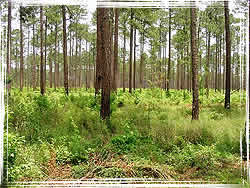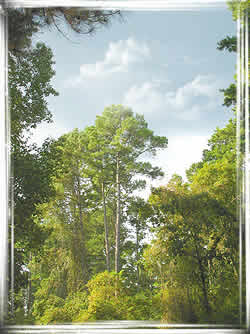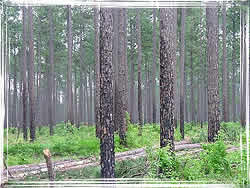Texas Eco-Regions
Pineywoods back to Eco-Regions Map
Elevation
Elevations range from 100 feet above sea level north of the coastal plane in Southeast Texas to more than 1,000 feet on higher ridges and peaks toward the western edge of the pine belt.
Precipitation
While rainfall can vary year to year, the Pineywoods are the wettest area of the state, with average annual rainfall ranging from 32 to 50 inches for most of the region.
Topography
Pine forest communities may usually be found on upland and mid-slope sites with gently rolling to near flat topography through out the region.
Soils
Most of the Pineywoods are occupied by deep, fertile, sandy loam soils which are generally slightly or moderately acidic, with a pH level of 6.5 to 4.5. Soils can be more acidic or alkaline depending on location.
Vegetation Description
The Pineywoods of East Texas are comprised of a rich variety of trees, shrubs, woody vines, and herbaceous vegetation. As the name implies, pine forest ecosystems dominate much of the landscape, although variations in soil type, drainage characteristics, as well as human disturbance, give rise to areas dominated by native hardwoods such as oaks, elms, hickories, pecan, black walnut, tupelo, sweetgum, and others. Shortleaf, longleaf, and loblolly pine are the three native species of southern yellow pine that occupy these commercially important forests. Slash pine may be observed in places as well, though it is not native to East Texas. Uplands may also be home to certain hardwoods, such as post oak and blackjack oak. Bottomlands near rivers and significant creeks are most often dominated by native bottomland hardwoods such as water oak, cherrybark oak, nutall oak, black hickory, bitternut hickory, black tupelo, and sweetgum. Dense understory growth may often be found in forest areas in the form of woody shrubs and small trees such as yaupon, waxmyrtle, American hornbeam, rusty blackhaw viburnum, and other species. In recent years, invasive species such as Chinese tallow, Japanese climbing fern, soda apple, etc., have become well established throughout the Pineywoods as well.
Impacts of Fire
Pine forests are fire climax systems, meaning that fire is necessary in order for pines to maintain dominance in the presence of hardwood competition. Historically, fire has played an important role in shaping East Texas as a pine community by controlling hardwood competition through cooler understory fires, or allowing for the re-introduction of pine seed after hot stand replacement fires. Wetter, low-lying areas with little to no fire occurrence developed into ecosystems dominated by hardwood.
Historical Information
Large scale settlement came to the Pineywoods as a result of the timber boom of the mid- to late 1800s, though many hardy settlers and Native Americans called the region home before then. Sawmills and company towns dotted the landscape, taking advantage of the wealth of virgin pine timber that covered the land. The forest operations of many of these early pioneers were not sustainable and many company towns and sawmills dwindled and disappeared by the early 1900s. Today the timber industry is still the largest source of jobs and income in the region, but the lessons learned from history serve as a reminder of the importance of sustainable forest management.




